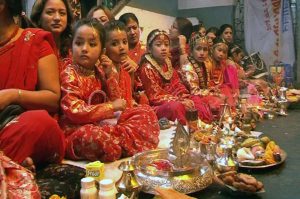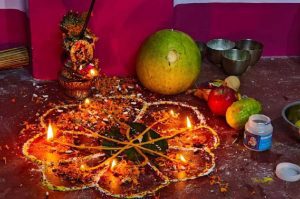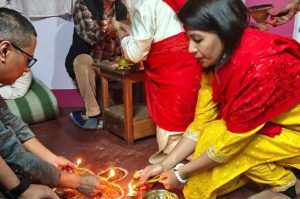Darjeeling Mha Puja: The crisp autumn air of Darjeeling’s hills once again carries the scent of incense, marigolds and freshly drawn mandalas. Within Newar homes scattered across Kurseong, Kalimpong, Darjeeling town and adjoining areas, the sacred and introspective ritual of Mha Puja — the worship of one’s own self — is being observed with quiet reverence, deep emotion and growing significance amid cultural transition.

For the Newar community residing in the Indian Himalayas, Mha Puja is more than just a ritual aligned with the Newar New Year (Nepal Sambat). It is a celebration of identity, resilience and self-worth — its meaning expanding every year as younger generations rediscover the importance of cultural belonging in a rapidly changing society.
🌼 Understanding the Core: What Mha Puja Truly Represents
The essence of Mha Puja lies in acknowledging the self as sacred. The body and soul are honoured as vessels of life:
- “Mha” = Self
- “Puja” = Ritual worship
Unlike common religious ceremonies that worship gods or ancestors first, Mha Puja reverses the spiritual gaze — urging people to treat their own existence as divine and worthy of care.
“When we honour our body, mind and spirit, we honour our entire connection with the universe,”
— A Newar elder in Darjeeling explained during this year’s celebration.
🎨 The Ritual: Symbolism in Every Step
Inside Newar households, the ceremony takes place in the evening. Each participant sits in front of a mandala — delicately crafted patterns made of rice flour and colours.
The ritual items include:
| Item | Symbolism |
|---|---|
| Mandala | The individual’s universe |
| Oil lamp (diyo) | Inner strength and enlightenment |
| Flowers & garlands | Purity and grace |
| Beaten rice and fruits | Nourishment and prosperity |
| Sacred thread/bindu | Cycles of life and protection |
The head of the family performs the rituals, circles lamps around faces, gives blessings, and places Tika of vermillion and rice on foreheads — wishing clarity and a clean spiritual path.
After the blessings comes the Mha Bhoj, a celebratory feast — featuring Newar delicacies like bara, aalu-tama, chhoila and yomari in some families.
🏔️ A Hill Culture Adapting Through Generations
Darjeeling has been home to Newars since the 1800s — arriving as artisans, traders, administrators and architects during the early colonial days. Today:
- Many Newar youth study or work outside the hills
- Nuclear families make rituals harder to maintain
- Urban pressures shrink time and space for tradition
Yet Mha Puja persists — and is even gaining renewed visibility.
Local Newar organisations now organise:
- Workshops on Newari cuisine
- Mandala art competitions
- Cultural classes on language and songs
- Heritage storytelling events


This community-driven revival is ensuring that tradition is not lost to the fast pace of modernity.
✨ Self-Worship as Emotional Wellness
In a world filled with stress, displacement and cultural confusion, the ritual acts as:
- A mindfulness exercise
- A reminder of self-love
- A path toward emotional grounding
Mental health workers in the region acknowledge the role rituals like Mha Puja play as collective healing experiences, especially for marginalised ethnic groups preserving cultural pride.
🧬 Identity in a Multi-Ethnic Hill Region
Darjeeling’s social tapestry includes:
- Gorkhas
- Lepchas
- Bhutias
- Bengalis
- Marwaris
- Newars
Amid identity-based politics and migration challenges, cultural rituals become essential pillars of community self-definition.


Mha Puja has therefore become:
✅ A symbol of Newar visibility and dignity
✅ A reminder of ancestral knowledge
✅ A way to pass heritage to future generations
“Our children must know that celebrating oneself is the foundation of celebrating our community,”
— A youth cultural worker in Kalimpong shared.
🔔 Connection with Newar New Year
Mha Puja coincides with the start of Nepal Sambat, marking renewal on both personal and time-cycle levels. Families clean their homes, decorate doorways, and perform Halah Bintuna rituals where elders bless younger generations for success in the New Year.
Thus, the festival becomes:
- Personal purification
- Family unity
- Community solidarity
Darjeeling Mha Puja: Challenges and the Road Ahead
Despite rising interest, hurdles remain:
▪ Declining use of Newa language
▪ Ritual simplification due to lack of knowledge
▪ Modern lifestyles overshadowing ancient value systems
▪ Commercial influences replacing deeper meaning
But pride remains strong — and cultural literacy movements are expanding across the hills.
🌍 External Informational Links — Government & Cultural Resources
(No other news channel links included ✅)
- Nepal Tourism Board (festival and cultural descriptions):
https://ntb.gov.np/mha-puja - UNESCO – Intangible Cultural Heritage Resources:
https://ich.unesco.org/ - Newar cultural preservation initiative:
https://bajracharya.org/mha-puja-worshipping-the-self/ - Anthropological reference on Newar festivals:
https://www.repository.np/bitstream/123456789/1234/1/newar-rituals-puja.pdf - Government of India Tribal & ethnic heritage schemes:
https://tribal.nic.in/
🌟 The Essence that Lives On
Mha Puja in Darjeeling’s hills is not merely a ritual performed once a year —
It is a reminder:
- To love oneself
- To acknowledge every breath as sacred
- To root identity deeply in culture
- To pass on wisdom from ancestors to children
In every mandala drawn, in each lamp lit, lies a message that resonates far beyond religious boundaries:
“Before you celebrate the world, celebrate yourself.”
As Darjeeling’s Newars continue this introspective celebration, Mha Puja stands tall as a symbol of self-respect, cultural pride and spiritual resilience, beautifully illuminating the hills each year.
Also read: Home | Channel 6 Network – Latest News, Breaking Updates: Politics, Business, Tech & More

